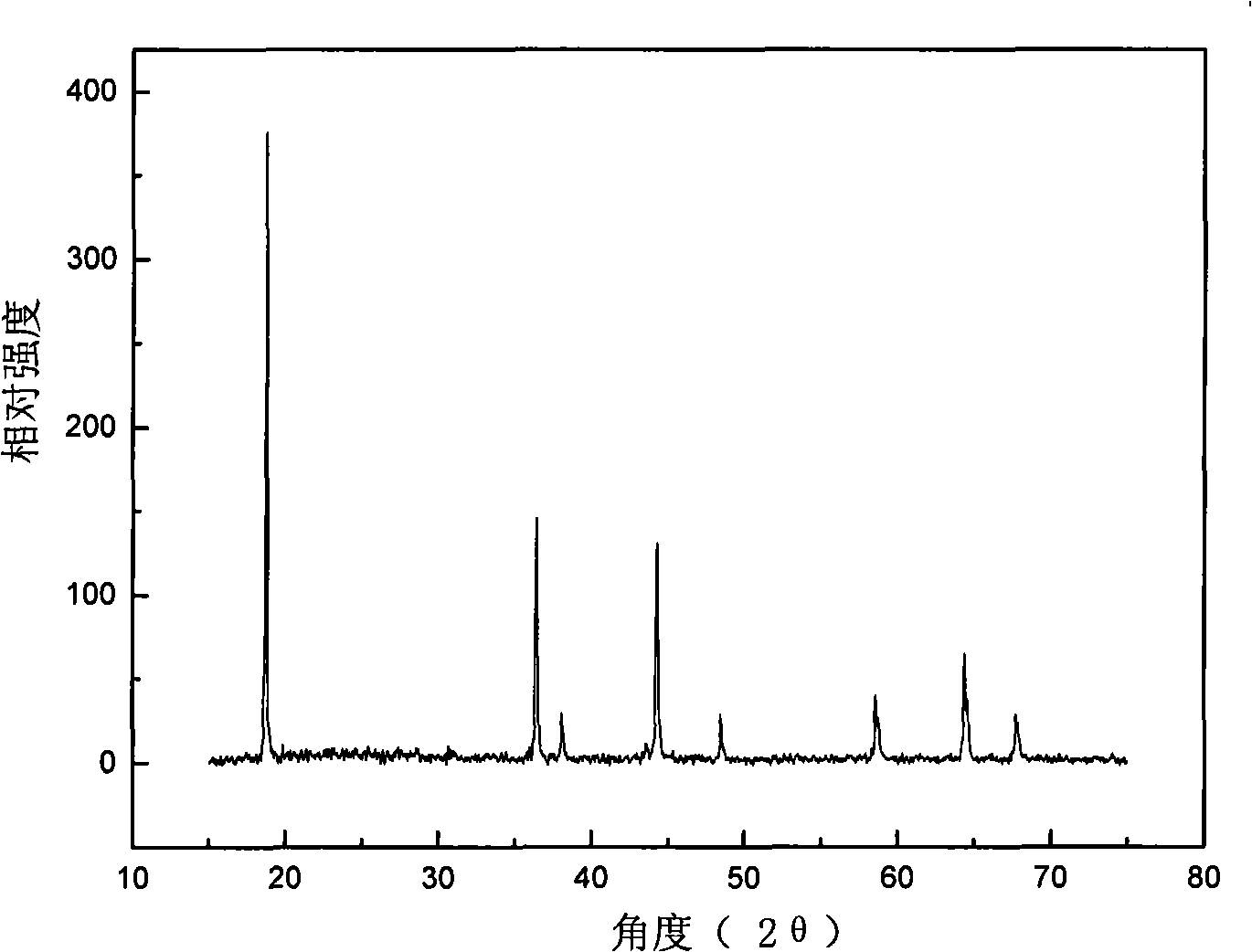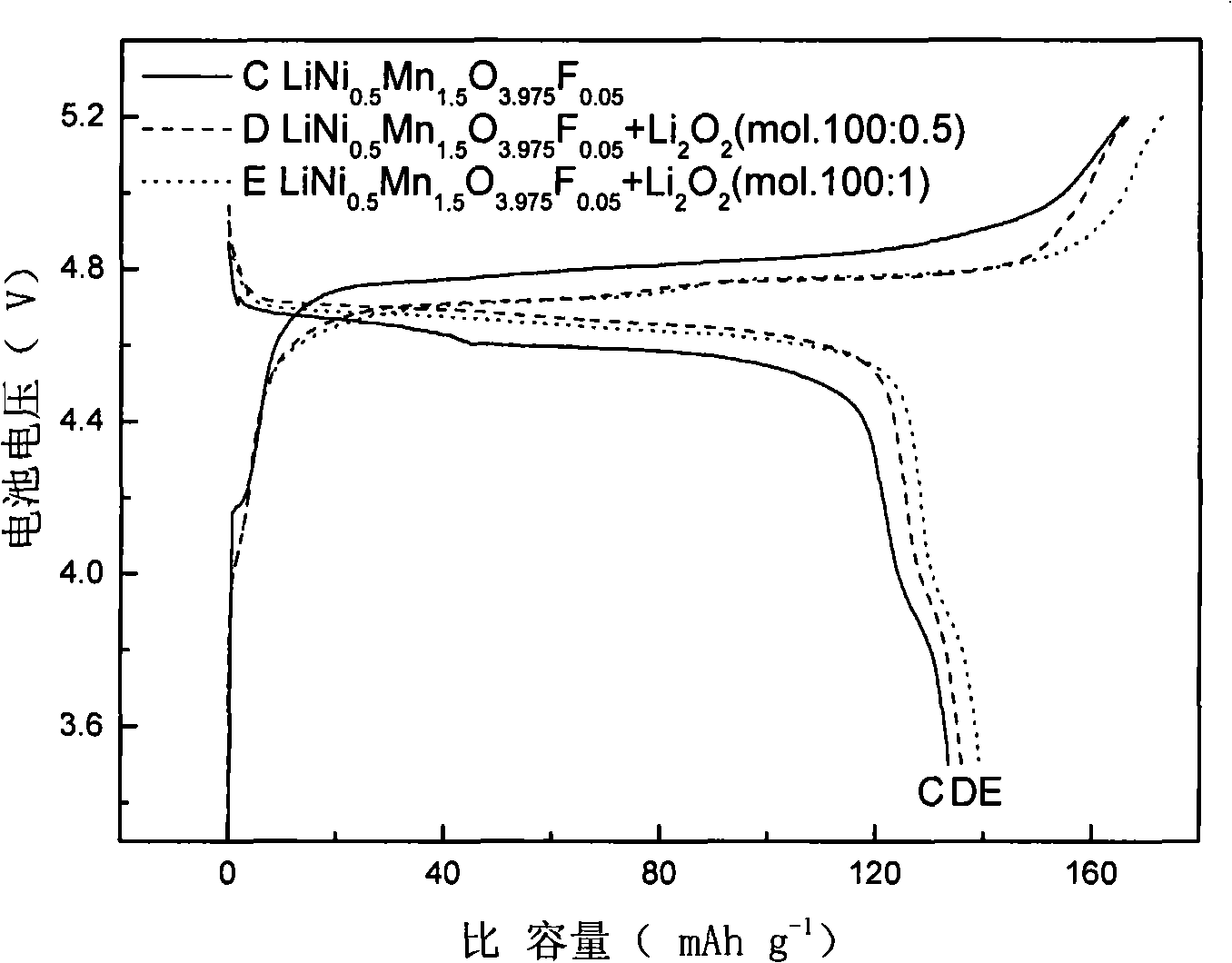Method for preparing anode material for lithium ion battery
A cathode material, lithium-ion technology, applied in the field of preparation of cathode materials for lithium-ion batteries, can solve the problems of low 5V capacity, capacity loss, and failure to solve the problem of crystallized oxygen defects in cathode materials
- Summary
- Abstract
- Description
- Claims
- Application Information
AI Technical Summary
Problems solved by technology
Method used
Image
Examples
Embodiment 1
[0028] Embodiment 1: lithium-ion battery positive electrode material LiNi 0.5 mn 1.5 o 3.975 f 0.05 Preparation of:
[0029] (a) Weigh 2.0404g lithium acetate (LiAC 2H 2 O), 2.4886g nickel acetate (Ni(AC) 2 4H 2 O), 7.3527g manganese acetate (Mn(AC) 2 4H 2 (0) and 0.0259g lithium fluoride (LiF), dissolved in 50ml deionized water, stirred for 4 hours, the stirring temperature was 80°C until a gel was formed;
[0030] (b) Put it into a quartz cup, in the air atmosphere of the tubular heating furnace, after calcining at 480°C for 5 hours, cool, and mix 3.05g (0.02 mole) of the product with 0.0092g (0.0002 mole) of lithium peroxide , grind evenly;
[0031] (c) Put it into a quartz cup, in the air atmosphere of a tubular heating furnace, calcinate at 800°C for 15 hours, cool, and grind to obtain LiNi, the positive electrode material for lithium-ion batteries. 0.5 mn 1.5 o 3.975 f 0.05 .
[0032] figure 2 Represents the LiNi prepared according to Comparative Example ...
Embodiment 2
[0033] Embodiment 2: positive electrode material LiNi for lithium ion battery 0.5 mn 1.5 o 3.975 f 0.05 Preparation of:
[0034] (a) Weigh 4.0808g lithium acetate (LiAC 2H 2 O), 4.9772g nickel acetate (Ni(AC) 2 4H 2 O), 14.7054g manganese acetate (Mn(AC) 2 4H 2 (0) and 0.0519g lithium fluoride (LiF), dissolved in 100ml deionized water, stirred for 4 hours, the stirring temperature was 80°C until a gel was formed;
[0035] (b) Put it into a quartz cup, in an air atmosphere in a tubular heating furnace, calcinate at 450° C. for 5 hours, cool, mix 6.0579 g of the resulting product with 0.0092 g of lithium peroxide, and grind evenly;
[0036] (c) Put it into a quartz cup, in an oxygen atmosphere in a tubular heating furnace, calcinate at 850°C for 12 hours, cool, and grind finely to obtain LiNi, a positive electrode material for lithium-ion batteries. 0.5 mn 1.5 o 3.975 f 0.05 .
Embodiment 3
[0037] Embodiment 3: positive electrode material LiNi for lithium ion battery 0.5 mn 1.5 o 3.975 f 0.05 Preparation of:
[0038] (a) Weigh 4.0808g lithium acetate (LiAC 2H 2 O), 4.9772g nickel acetate (Ni(AC) 2 4H 2 O), 14.7054g manganese acetate (Mn(AC) 2 4H 2 (0) and 0.0519g lithium fluoride (LiF), dissolved in 100ml deionized water, stirred for 4 hours, the stirring temperature was 80°C until a gel was formed;
[0039] (b) Put it into a quartz cup, in an air atmosphere in a tubular heating furnace, calcinate at 450° C. for 5 hours, cool, mix 6.0579 g of the resulting product with 0.0184 g of lithium peroxide, and grind evenly;
[0040] (c) Put it into a quartz cup, in an oxygen atmosphere in a tubular heating furnace, calcinate at 850°C for 12 hours, cool, and grind finely to obtain LiNi, a positive electrode material for lithium-ion batteries. 0.5 mn 1.5 o 3.975 f 0.05 .
[0041] image 3 Represents the LiNi prepared according to Comparative Example 1 (sample...
PUM
 Login to View More
Login to View More Abstract
Description
Claims
Application Information
 Login to View More
Login to View More - Generate Ideas
- Intellectual Property
- Life Sciences
- Materials
- Tech Scout
- Unparalleled Data Quality
- Higher Quality Content
- 60% Fewer Hallucinations
Browse by: Latest US Patents, China's latest patents, Technical Efficacy Thesaurus, Application Domain, Technology Topic, Popular Technical Reports.
© 2025 PatSnap. All rights reserved.Legal|Privacy policy|Modern Slavery Act Transparency Statement|Sitemap|About US| Contact US: help@patsnap.com



